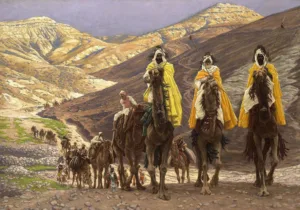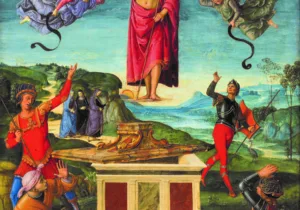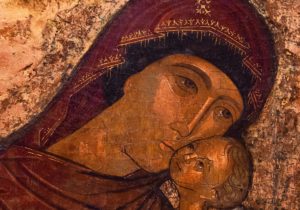Now it gets tough. Yesterday’s post at the Yule Blog looked at what divides Christians and other theists from atheists; today we cut deeper and look at what separates Christians from believers in other religions.
And the truth is that nothing separates Christianity from other religions like the two big holidays of Christmas and Easter. I hope to blog about Easter some other time, but in some ways even the shock of the resurrection is less divisive than Christian ideas about what happened on Christmas. That little baby wrapped in swaddling clothes and lying so demurely in the manger is the biggest troublemaker in world history, and the shocking claims that Christianity makes about who He is and what He means irritate and antagonize people all over the world.
If Christians saw that little baby as nothing more or less than a beautiful symbol of human innocence and love, there would be no problem. Even recognizing Him as an important teacher and religious leader does not raise many hackles. Islam recognizes Jesus as a prophet and the predicted Messiah; as we have seen, Islam has no trouble with the idea that He was born of a virgin, and the Virgin Mary is a popular and well-respected figure for Muslims. When it comes to His moral teaching, much of what Jesus says is unexceptionable. The Golden Rule (“do unto others as you would have others do unto you”) has its analogs in many religious traditions. Jesus’ summary of the moral law (“love the Lord your God with all your heart, soul, mind and strength, and love your neighbor as yourself”) is both drawn from and perfectly compatible with Judaism and is also something that people from many different religious traditions can take to heart. Many non-religious people (and non-Christians like Mahatma Gandhi) have been inspired by Jesus’ example and teaching. If Christians were simply celebrating the birth of a moral teacher on Christmas, there would be little controversy about it.
But that’s not how most Christians see the baby in the manger. They don’t think He is a symbol; they don’t think He’s just a messenger. They think He is the real thing. He is the meaning of meaning, the truth made flesh, the only begotten Son of God. As a grown man, He would tell people that “I and the Father are one.” Most of the people we call Christians believe He was right, and speak of the baby Jesus and the man He grew to be as one of the Three Persons of God.
For both Muslims and Jews, it is hard to know which is more blasphemous: saying that the One God is Three Persons, or saying that Jesus of Nazareth is God made man. Either way, to many people this is an ugly theological scandal, a fundamental betrayal of the essence of monotheism. It’s an atrocity to worship a creature, a human being, however noble, as God; it’s an atrocity to mingle polytheism with monotheism; it’s an atrocity to blur the bright line between Creator and creation by mixing the two together in the person of Jesus.
The Christian betrayal of monotheism, from this perspective, is damaging and deep. Monotheism isn’t just about the proposition that God is one and indivisible; it is also a statement about God’s transcendence. The One God is incomparably greater than and infinitely above human beings. While God is compassionate and caring, there is an infinite distance between the Creator and the created, between God and man. For most members of the other monotheistic religions (except for some mystics often viewed with suspicion by the mainstream), getting into a right relationship with God involves acknowledging and accepting this truth.
The Christian idea that Jesus is God, non-Christian monotheists feel, is a direct assault both on God’s unity and His transcendence. Before Moses and Mohammed, people worshiped gods who were both numerous and close to mankind. Coming to see God as one and one only and as infinitely distant and above all other spirits and forces—to say nothing of human beings—is the giant step that separates the monotheists from the pagans.
It is a moral step as well as a philosophical one. The polytheism of the Greeks, the Romans, and many in the ancient Near East was a kind of moral polygamy. There was a war god and a love goddess, a god of thieves and a god of doctors. The old pagans in the Greco-Roman world were postmodernists before modernism was born; they had no grand narratives, no overarching single moral vision. Pagan beliefs often weren’t morally serious; everything from ritual prostitution to the fiery sacrifice of living babies could be found in the religious rituals of the pagan Middle East. Drawing a bright, clear line between the moral chaos and philosophical incoherence of idolatry and the absolute claims of morality and truth was the distinctive, world-changing contribution of monotheistic religion to human understanding. To both Muslims and Jews, Christianity can look like an uneasy and messy compromise between ancient paganism and true worship of the One God. It feels to many like a falling away from the high ethical and philosophical achievement of monotheistic religion.
For many Muslims, shirk, the improper association of the created with the creator, is the ultimate in blasphemy. For many Jews, to worship a human being as God is idolatry—one of the worst sins there is. Christianity’s core belief that the baby in the manger is God made man looks exactly like idolatry of the worst kind to the other Abrahamic religions.
And, as both Jews and Muslims have pointed out for many centuries, this Christian idea that Jesus is in some way God immediately opens up dozens of tough theological questions. Christians have squabbled and often shed blood over the many different ways theologians have tried to define and explain the Trinity—and the Incarnation of God in Christ. There has never been a time when all the world’s Christians reached an agreement about the meaning of these great doctrines. Words like Homoousion and Filioque continue to divide the world of Christianity over what to most people seem to be arcane points of doctrine.
The reason Christians argue endlessly over the nature of the Trinity and the doctrine of the Incarnation, many maintain, is because these doctrines are nonsensical to begin with. There can be no clear and logical conclusion to a debate over incoherent ideas.
This little Yule Blog post isn’t going to settle these great controversies, and it’s above my pay grade even to explain them. My goal is much more modest: to help Christian and non-Christian readers understand what classical vanilla Christians mean when they identify the baby in the manger with God on high. That means taking on the most controversial and complex idea in Christianity; the doctrine of the Trinity is wrapped around that baby in the manger even tighter than the swaddling clothes.
In the old days, almost every educated American, whether Christian or not, would have some idea about what this doctrine meant. Not all Americans were Trinitarians; in addition to Jews and the very small number of Muslims in the United States at the time, Unitarians, Mormons, and a great many freethinkers also disapproved of the concept. But understanding this idea and at least something of its history seemed important enough for the sake of understanding American and Western history literature and art that even secular institutions of learning made some effort to ensure that students learned about the Trinity.
That isn’t happening much anymore; many people who think they are extremely well-educated don’t know much about these ideas, and many schools don’t teach them as part of a general cultural curriculum. Unfortunately, this means that young people will have to pick up their knowledge of core religious ideas from disreputable bloggers like yours truly.
Like all Christian ideas, the concept of the Trinity is rooted in the Bible. The New Testament books speak of God in Three Persons. There is the Father (“Our Father who art in heaven” as Jesus prayed in the Lord’s Prayer), the Son (Jesus), and the Holy Spirit, sometimes called the Holy Ghost in older English translations. (The English word “ghost” is related to the German “Geist,” and in earlier times had the same range of meaning that the German word preserves.) A clear Trinitarian worldview is already apparent in the earliest surviving Christian documents; in subsequent years, Christian scholars and theologians tried to make sense of this language and gradually elaborated the complex and subtle theology of the Trinity that most of the world’s Christians today accept. The Quicunque Vult, or the “Athanasian Creed,” is an early document that gives some idea of the complexity of the Trinitarian idea as theologians hammered it out; it is enough for our purposes to know that most Christians believe that the God of the Bible is best described as one God in Three Persons: Father, Son, and Holy Spirit.
The question of how one God can exist in Three Persons has perplexed inquiring minds for a very long time. St. Patrick famously explained the doctrine of the Trinity to new Irish converts by showing them a shamrock (a.k.a., a cloverleaf): three lobes, one leaf. Others have used examples like a triangle: three sides, one figure. As a mere lay blogger, I don’t have the theological chops to present a technically sophisticated and theologically nuanced presentation of the doctrine, so I’ll try to start from a different place—from this question of meaning that we have been tracing through Christmas.
I wrote earlier that theism is rooted in the intuition that the meaning we experience in our lives and our interactions with other people adds up to something real.
Like the other monotheistic religions, Christianity moves from the idea of meaning to the idea of a personal God, but Christianity goes a step further. It identifies God with one particular aspect of meaning: love. “God is love,” says one of the letters that make up the New Testament (1 John 4:8). This is the phrase that Pope Benedict XVI chose for the title of his first encyclical letter, but this is very far from some kind of unique Roman Catholic idea; it resonates through the history and theology of all the Christian denominations like nothing else.
Christians really mean this. When they say “God is love” they don’t just mean that God is a being who loves. They aren’t just saying that God is nice, or that He is compassionate and forgiving. They mean that what we think of as “love” is the core of His nature, the key to His being.
(A quick aside on a translation problem. Ancient Greek, the language in which the New Testament was originally written, had three basic words that are often translated as “love” in English. One word stands for erotic love and desire; one means friendship; the third [ἀγάπη, in English letters, agape] means benevolence. It has often been translated into Latin as the word “caritas,” and our modern English word “charity” comes from it. Agape love is philanthropic, wishing well to people and seeking their good without being motivated by a thought of return, or by physical desire.)
Love, agape, isn’t something outside God; love is the nature of God. Love is by nature communal. It isn’t solitary; it is directed outwards. From the standpoint of love, life isn’t life if it isn’t shared. So, to be God is to love—and to love is to be in community and relationship. God, Christians believe, made the world out of and for love.
But God wasn’t incomplete before there was a world; God was love before there was a creation for Him to be in love with. Yet to love is to be in relationship. Ultimately, I think, what Christians mean by the doctrine of the Trinity is just this: Because God is love, community and relationship are rooted in the depths of His being. Community is intrinsic to God. His unity is communal. He is one and He is three.
Among the many classes of people who dislike this idea, two are particularly prominent: rationalists, and convinced monotheists who don’t buy the Christian package. For rationalists, the idea that God is many and God is one is a contradiction of the most elementary principles of logic. This was the part of Christianity that many of the Founding Fathers and other enlightened and educated people of the Age of Reason had the most trouble with. They wanted a God who was logical; the Trinity didn’t fit. The logic was clear: A is not non-A; one is not three.
Today, this is less of an issue for most people. We have all grown so accustomed to living with conflicting paradigms and grand narratives that we are less strictly logical than many of our ancestors were. This isn’t always a good thing; a healthy dose of Aristotelian logic would clarify a lot of the confusions that vex our political and cultural discourse today. Even so, it makes the concept of a Trinity less difficult for contemporary minds to accept. Two hundred years ago, “enlightened” minds generally accepted the existence of God without much trouble but boggled at the concept of the Trinity. Today, those minds have more trouble accepting the existence of God; if they do accept that existence, the problem of the Trinity doesn’t usually loom as large as it once did.
This is partly because our scientific paradigms have changed. The science of 1800 was pretty open and shut: a thing was either true or false, and the whole point of science in those days was to take vague folk beliefs and inherited ideas and subject them to ruthless experiment and logical analysis. These days, physics tends to broaden the mind; after even casually wrestling with modern physics, many people are more comfortable than they used to be with the idea that the basis of existence may violate human expectations and logical categories. If light can be both particles and waves, maybe God can be both unitary and communal. If we perceive three dimensions but it is necessary to think of many more to construct a mathematically sensible model of how the universe works, we are less insistent that the concepts we use match everyday assumptions.
(There may be another reason why Americans in particular are predisposed to accept the idea of a Trinity. We have one federal government, established under one Constitution, divided into three branches. If we can be Trinitarian in our politics, why not also in our theology?)
The remaining objection to the Trinity from the other Abrahamic monotheisms is still vibrant and influential. This is not a religiously polemical blog—at least I’m trying to keep it from turning into one. I can understand why people from other religious backgrounds and traditions see the Trinitarian idea as chipping away at the transcendence and the uniqueness of God, and I respect their concerns. Christians, obviously, don’t share this objection. For Christians, to say that the divine unity is so unimaginably deep, rich, and transcendent that what humans understand as community is inextricably bound up with God’s unique being doesn’t undermine God’s transcendence. It underlines God’s transcendence: it gives our idea of God’s unity a depth that emphasizes just how unique and unimaginable the Creator really is.
For Christians, God is a different order of being than we are, and one of the ways in which He is different is that for Him there is no contradiction between the singular uniqueness of who He is, and the fact that His essence is community, relationship, and love.
Christians see this communal nature of the One God as a further affirmation of the basic intuition of theism: that our experience of the meaning in life points us toward the divine. People are social beings and much of the meaning and transcendence we find in life is related to our participation in social units ranging from the family to the global human community. We are individuals, but we only become our fullest selves in relationships. This is one of the ways that human beings are made in the image of God. ἀγάπη is hardwired into us; we are not really ourselves unless we stand in relation to others. God similarly can only be Himself in loving; since God can never be less than fully Himself, we must understand His being as complex enough to give full scope to this aspect of who He is.
This at least is an introduction to the way Christians think about the nature of God. The Three Persons mentioned in the New Testament—Father, Son, and Holy Spirit—are often seen as expressing the complex love that is the nature of God. The Father is seen as the source of love, the Son as the object of that love, and the Holy Spirit as the love that exists between the two. This is the love that made the world, not because it was incomplete or lacking but because it wanted to share.
In any case, Christians believe that the baby in the manger was the Second Person of the Trinity, taking on human flesh and coming to live among us. As John Milton put it in his 1629 Nativity Ode:
That glorious Form, that Light unsufferable,
And that far-beaming blaze of Majesty,
Wherwith he wont at Heav’ns high Councel-Table,
To sit the midst of Trinal Unity,
He laid aside; and here with us to be,
Forsook the Courts of everlasting Day,
And chose with us a darksom House of mortal clay.
It is a terrible scandal, but there is no way to separate the Trinity from Christmas. God is One; God is Three; the baby Jesus is the Second Person of the Trinity, come to earth to save sinners and open the door to a new kind of relationship between human beings and God. When Christians sing Christmas carols, buy gifts for each other, give holiday money to charities, or go to church, this is what they are celebrating and this is what they believe.







 Sponsor a student for Christianity & National Security 2024
Sponsor a student for Christianity & National Security 2024